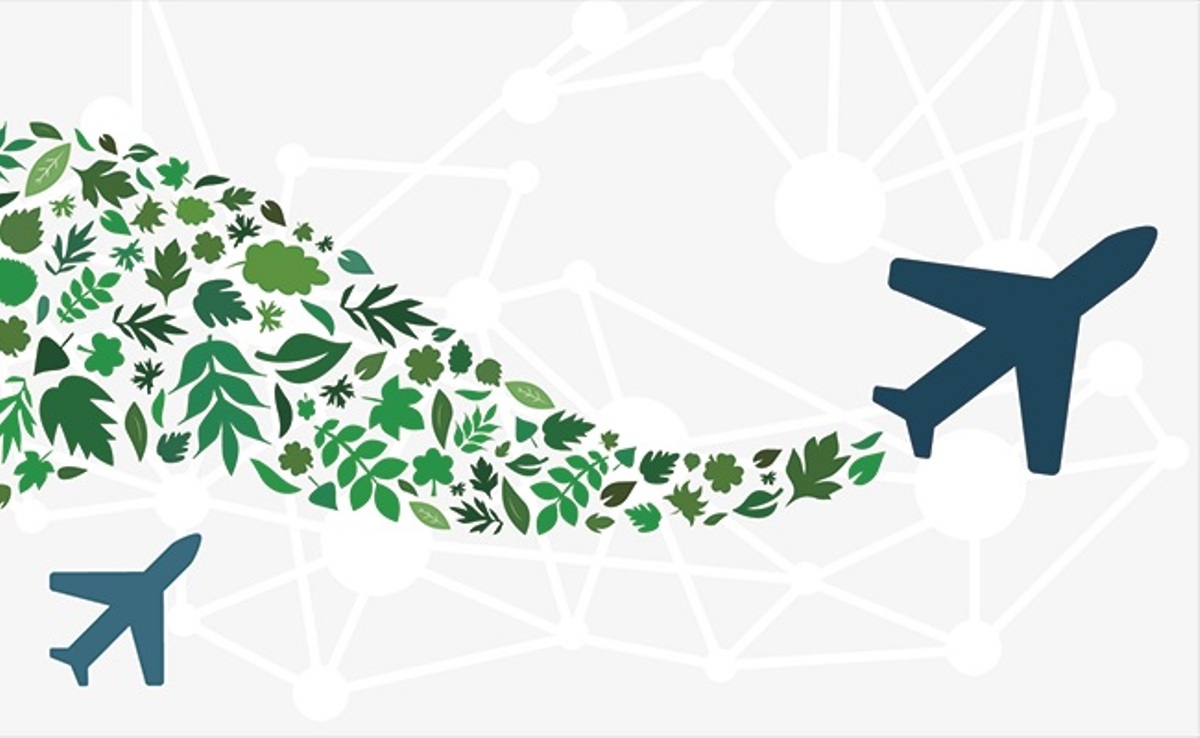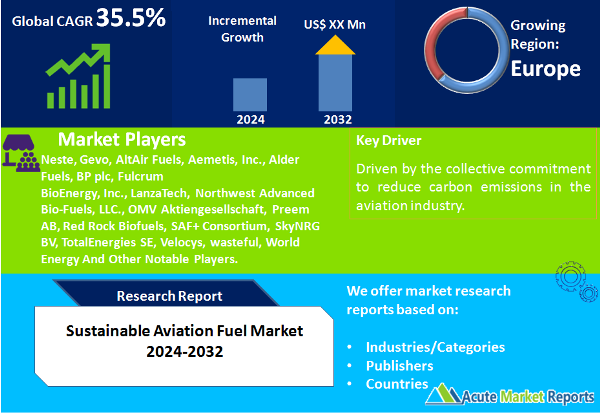
The sustainable aviation fuel market is expected to grow at a CAGR of 35.5% during the forecast period of 2024 to 2032, driven by the collective commitment to reduce carbon emissions in the aviation industry. The three drivers, including rising environmental awareness and regulatory initiatives, advancements in manufacturing technologies, and growing blending capacities and flexibility, underscore the transformative potential of SAF in reshaping the aviation landscape. However, the limited adoption of hydrogen fuel poses a notable restraint, emphasizing the need for collaborative efforts to overcome infrastructure and cost barriers associated with hydrogen-based SAF. The detailed market segmentation provides insights into the preferences for fuel types, manufacturing technologies, blending capacities, and platforms, reflecting the diverse applications of SAF across the aviation sector. The geographic segment highlights regional dynamics influencing market growth, with North America and Europe playing pivotal roles in the industry's expansion. Competitive trends showcase key players shaping the industry landscape, with a focus on strategic initiatives to maintain market dominance. As the market progresses from 2024 to 2032, advancements in technology, increased blending capacities, and collaborations are expected to drive sustained growth in the sustainable aviation fuel market. The global nature of the market, coupled with regional variations, offers a dynamic landscape for industry players to navigate and capitalize on emerging opportunities, contributing to a more sustainable and environmentally friendly future for aviation.
Key Market Drivers
Rising Environmental Awareness and Regulatory Initiatives
The adoption of sustainable aviation fuel (SAF) is propelled by heightened environmental awareness and robust regulatory initiatives. Evidenced by global efforts to curb carbon emissions in aviation, companies such as Neste and World Energy are at the forefront of this driver. In 2023, the Biofuel segment emerged as the dominant fuel type, both in terms of revenue and the highest Compound Annual Growth Rate (CAGR) during the forecast period from 2024 to 2032. This growth is supported by the increasing emphasis on renewable and low-carbon fuel sources, aligning with international agreements such as the CORSIA (Carbon Offsetting and Reduction Scheme for International Aviation). Regulatory mandates and voluntary commitments from airlines to reduce their carbon footprint contribute to the substantial growth of SAF, particularly in the biofuel category.
Advancements in Manufacturing Technologies
The sustainable aviation fuel market is buoyed by continuous advancements in manufacturing technologies. Evidenced by the development of Fuel-to-Synthetic Paraffinic Kerosene (FT-SPK) and Hydroprocessed Esters and Fatty Acids-Synthetic Paraffinic Kerosene (HEFA-SPK), companies like Gevo and Velocys play a pivotal role in this driver. In 2023, the FT-SPK manufacturing technology led in terms of both revenue and the highest expected CAGR during the forecast period. This underscores the significance of innovative production methods that enhance the efficiency and scalability of SAF. The continuous exploration and implementation of alternative manufacturing technologies contribute to the diversification of SAF sources, making it a key driver in the industry's evolution.

Growing Blending Capacities and Flexibility
Another crucial driver for the SAF market is the growing blending capacity and flexibility in fuel formulations. Evidenced by the increasing adoption of SAF blends with conventional jet fuels, companies such as AltAir Fuels and REG Synthetic Fuels contribute to this trend. In 2023, the segment with a blending capacity above 50% exhibited the highest revenue and CAGR during the forecast period. This growth signifies the industry's inclination towards high-blend SAF solutions, providing airlines with flexibility in transitioning to sustainable fuel sources without major modifications to existing aircraft and infrastructure. The emphasis on higher blending capacities aligns with the industry's goal to achieve a more significant impact on reducing overall carbon emissions in aviation.
Restraint
Despite the positive growth drivers, a notable restraint in the sustainable aviation fuel market is the limited adoption of Hydrogen Fuel. Evidenced by the challenges associated with the production, storage, and distribution of hydrogen-based SAF, this restraint poses a significant obstacle to market expansion. Companies operating in this space, including Air Liquide and Plug Power, face difficulties in overcoming the infrastructure and cost barriers associated with hydrogen-based SAF. In response to this constraint, industry participants are actively exploring solutions to enhance the viability of hydrogen fuel as a sustainable aviation option. The limited adoption of hydrogen-based SAF underscores the need for collaborative efforts, technological innovations, and infrastructure developments to address the challenges hindering its widespread use in the aviation sector.
Market Segmentation Analysis
Market by Fuel Type: Biofuel Segment Dominates the Market
The market segmentation based on fuel types distinguishes between Biofuel, Hydrogen Fuel, Power to Liquid, and Gas to Liquid. In 2023, the Biofuel segment led in terms of both revenue and the highest CAGR during the forecast period. This highlights the dominant position of biofuels as a preferred sustainable aviation option, driven by their renewable nature and compatibility with existing aircraft and infrastructure. The continuous advancements in biofuel production technologies contribute to the sustained growth of this segment, positioning it as a key player in the SAF market.
Market by Manufacturing Technology: FT-SPK Manufacturing Technology Dominates the Market
The segmentation based on manufacturing technologies delineates the demand for SAF produced through different processes, including FT-SPK, HEFA-SPK, HFS-SIP, ATJ-SPK, CHJ, FT-SPK/A, and HC-HEFA-SPK. In 2023, the FT-SPK manufacturing technology led in terms of revenue and the highest CAGR during the forecast period. This underscores the significance of synthetic paraffinic kerosene produced through Fischer-Tropsch (FT) processes in driving market growth. The continuous advancements in manufacturing technologies, including hybrid approaches like FT-SPK/A, contribute to the diversification of SAF sources, catering to the varied needs of the aviation industry.
Market by Blending Capacity: Blending Capacity Above 50% Dominates the Market
The market segmentation based on blending capacities categorizes SAF blends as Below 30%, 30% to 50%, and Above 50%. In 2023, the segment with a blending capacity above 50% exhibited the highest revenue and CAGR during the forecast period. This emphasizes the industry's inclination towards high-blend SAF solutions, providing airlines with flexibility in transitioning to sustainable fuel sources. The continuous focus on higher blending capacities aligns with the industry's goal to achieve a more significant impact on reducing overall carbon emissions in aviation.
Market by Platform: Commercial SegmentDominates the Market
The segmentation based on platforms delineates the demand for SAF across Commercial, Regional Transport Aircraft, Military Aviation, Business & General Aviation, and Unmanned Aerial Vehicles. In 2023, the Commercial segment led in terms of both revenue and the highest CAGR during the forecast period. This highlights the widespread adoption of SAF in commercial aviation, driven by airlines' commitments to sustainability goals and regulatory pressure. The diverse applications of SAF across various platforms underscore its versatility and potential to contribute to emissions reduction in different segments of the aviation industry.
Europe Remains the Global Leader
The geographic segment analyzes trends, identifying regions with the highest CAGR and revenue percentage in the SAF market. In the forecast period from 2024 to 2032, North America is expected to exhibit the highest CAGR, driven by stringent regulatory frameworks, increased awareness, and significant investments in sustainable aviation initiatives. Europe is anticipated to maintain the highest revenue percentage, owing to the region's proactive approach to environmental sustainability, strong support for renewable energy sources, and collaborations between governments and industry stakeholders. These geographic trends underscore the global nature of the SAF market, with regional variations influencing market growth.
Market Competition to Intensify during the Forecast Period
The competitive trends in the sustainable aviation fuel market highlight top players and their key strategies, providing an overall outlook on the industry landscape. In 2023, companies such as Neste, Gevo, AltAir Fuels, Aemetis, Inc., Alder Fuels, BP plc, Fulcrum BioEnergy, Inc., LanzaTech, Northwest Advanced Bio-Fuels, LLC., OMV Aktiengesellschaft, Preem AB, Red Rock Biofuels, SAF+ Consortium, SkyNRG BV, TotalEnergies SE, Velocys, wasteful, and World Energy emerged as key players, leveraging their expertise in biofuel production, advanced manufacturing technologies, and strategic collaborations. The key strategies employed by these players include continuous research and development, expanding production capacities, and forming partnerships with airlines and government agencies to promote SAF adoption. As the market progresses from 2024 to 2032, the competitive landscape is expected to witness increased investments in research and development, technological innovations, and collaborations to address emerging market trends and maintain a competitive edge.
Historical & Forecast Period
This study report represents analysis of each segment from 2022 to 2032 considering 2023 as the base year. Compounded Annual Growth Rate (CAGR) for each of the respective segments estimated for the forecast period of 2024 to 2032.
The current report comprises of quantitative market estimations for each micro market for every geographical region and qualitative market analysis such as micro and macro environment analysis, market trends, competitive intelligence, segment analysis, porters five force model, top winning strategies, top investment markets, emerging trends and technological analysis, case studies, strategic conclusions and recommendations and other key market insights.
Research Methodology
The complete research study was conducted in three phases, namely: secondary research, primary research, and expert panel review. key data point that enables the estimation of Sustainable Aviation Fuel market are as follows:
Market forecast was performed through proprietary software that analyzes various qualitative and quantitative factors. Growth rate and CAGR were estimated through intensive secondary and primary research. Data triangulation across various data points provides accuracy across various analyzed market segments in the report. Application of both top down and bottom-up approach for validation of market estimation assures logical, methodical and mathematical consistency of the quantitative data.
| ATTRIBUTE | DETAILS |
|---|---|
| Research Period | 2022-2032 |
| Base Year | 2023 |
| Forecast Period | 2024-2032 |
| Historical Year | 2022 |
| Unit | USD Million |
| Segmentation | |
Fuel Type
| |
Manufacturing Technology
| |
Blending Capacity
| |
Platform
| |
|
Region Segment (2022-2032; US$ Million)
|
Key questions answered in this report